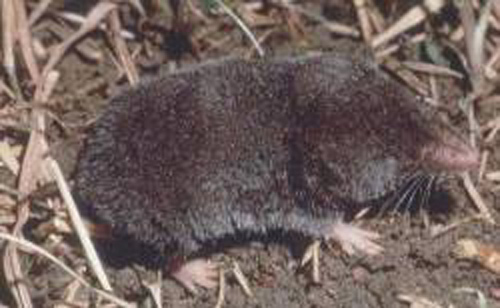The Northern short-tailed shrew is a common Connecticut shrew in wooded areas and open areas that are not too dry. These shrews have silvery gray fur, a short, thin tail about an inch long, and pointy faces. They have two incisors that protrude forward. Their teeth have reddish brown tips as do those of all shrews in the US. They are tiny critters weighing only 1/2 to 1 oz. Shrews are tinier than moles.
These shrews range through the northeastern US from Nebraska eastwards. They are also found in southeastern Canada. They are one of the highest population small mammals in their region. They are active year-round, although activity may slow in extreme cold. Shrews are diggers and make underground passages near the surface. They also use tunnels dug by other underground digging mammals such as moles or voles. The tunneling can cause damage to lawns, but in a trade-off many of the insects in a shrew's diet are damaging lawn pests. In the winter shrews are active in the airspace between the ground and snow cover. Nests are built in an underground chamber or under a log and lined with fur or leaves. Sometimes the shrews store a food supply in nests. A sign of a shrew nest might be a pile of old snail shells.
Living underground does not require much vision. It is not clear how much they can see, if anything, but their vision certainly isn't very good.
Shrews are insectivores. Earthworms are a dietary staple. Centipedes, beetles, snails and slugs are also eaten. Shrews will also eat smaller shrews, mice and voles, especially young ones. These little mammals have a high metabolism and consume an enormous amount of food per day in relation to their size. Captive shrews can eat their body weight's worth of food per day. The northern short-tailed shrew produces poisonous saliva, a rarity for mammals. The poison paralyses the small insects that they eat, but it is also strong enough to kill other tiny mammals. Their saliva will not kill a human, but can produce a very painful bite.
Northern short-tailed shrews are solitary animals. They mate throughout the spring and summer and can produce up to 4 litters.
Other ShrewsThe Northern Short-tailed Shrew is one of 5 shrew species found in this state. Also living in Connecticut are the very common Smoky Shrew, Sorex fumeus, the very common Masked Shrew, Sorex cinereus, the less common Water shrew, Sorex palustris, and the rare, endangered Least Shrew, Cryptotis parva. All are primarily insectivores, have similar body types and pointy faces.
The Smokey Shrew weighs 1/4 oz and has a long tail.
The teeny 1/16 to 1/4 oz Masked Shrew is brownish and has a long, tufted tail.
The 1/2 oz Water Shrew swims and dives.
Least Shrews weigh 1/8 to 1/4 of an ounce. Unlike the others, they are social and may live in groups.
Neat Fact
The Northern Short-tailed Shrew uses echolocation. It can detect how sound waves from its squeaks are reflected and find prey this way.
